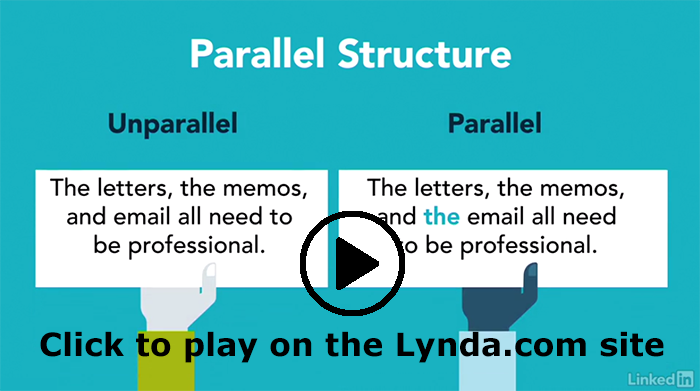The columns of information in your Analysis project should use parallel grammatical structures. I’m sure that you all know what the word parallel means. You probably encountered the term before you came to Virginia Tech in a geometry course.
You have probably seen the concept in courses here at Tech as well. Consider these examples:
- A mechanical engineering major is likely to be aware of parallelism control and parallelism tolerance.
- A building construction major surely knows that various parts of a building need to be parallel. (Imagine how annoying a staircase would be if the steps weren’t parallel.)
- A computer science or computer engineering major knows all about parallel processing.
- A finance major would probably be familiar with parallel portfolio optimization, parallel loans, and parallel markets.
- A business major may know about organizational parallelism, including parallel leadership and parallel learning.
In all these examples, parallel generally means that two or more things match in some way. That is essentially what parallelism means in a writing course as well. When you are composing your Analysis table, choose parallel phrasing for the information in each column. For example, you might start everything in the purpose column with infinitive verbs (verb phrases that start with “to,” such as “to explain” or “to provide”).
You can find out more about parallelism in the Lynda.com video on Parallel Structures (6m40s). The video begins with details on parallelism within a single sentence. At 4m50s into the video, the video discusses parallelism in bullet lists, outlines, and headings. That section of the video is closest to the kind of parallelism you will use for the columns of your Analysis table.
Lynda.com Login Help
Lynda.com videos are free to Virginia Tech students with your VT.EDU login. Start at the VT.EDU login page to access these resources.
Note: This video has closed captioning, so it does not need a transcript.

6 Comments
I had a hard time changing an un-parallel phrase or sentence to a parallel phrase or sentence in some of the examples shown in the video. With that being said, I’ll definitely refer back to this article when I start writing my next assignment.
I love seeing and using parallelism in writings. I think the flow of parallel sentence structures and phrases really helps drive a point home, and I think it makes ideas more memorable for readers. I sometimes tend to mess up parallelism in lists and tables as I’ll start one point with “to” and another with a verb or adjective. This information will remind me to maintain that structure while writing my comparisons.
The video was right; I have been taught that varying sentence structure keeps the reader interested because they are not reading the same sentence over and over again. However, I can see how keeping sentences parallel and in congruence can help the reader have a better understanding about what information is being conveyed. It makes the information easy to read because the reader only needs to focus on the changing subject rather than the whole sentence. This allows the reader to grasp the concept quickly and efficiently. Although parallel structure may seem like a simple concept, its ability to be used in both simple and complex situations shows its importance in professional writing.
Parallelism is a great tool to prime your brain to take in information. That being said, for me to compose parallel sentences I have to actively think about my sentences’ structures.I feel that parallelism is an easy concept to understand but a difficult skill to master and I am happy that Lynda has a refresher video about this.
I wish parallelism were more commonly taught. Much like how pattern recognition can be used in graphical design to make the graphic more appealing and easier to read, parallelism does the same with language. As much as varying sentence structure to keep writing from becoming bland is important, I argue that not sacrificing parallel structures for variation is more important. I suppose there is a balance between variation and parallelism and no set rule of where and how to use them. With any possible “rule” of structure or form (excluding grammar) for writing I see, my mind goes to George Orwell’s 6th rule from his “Politics and the English Language”, which states “[b]reak any of these rules sooner than say anything outright barbarous.”
I really like using Parallel structures because it makes the sentences easier for the reader to understand. Also, it helps to establish balance in the sentences.